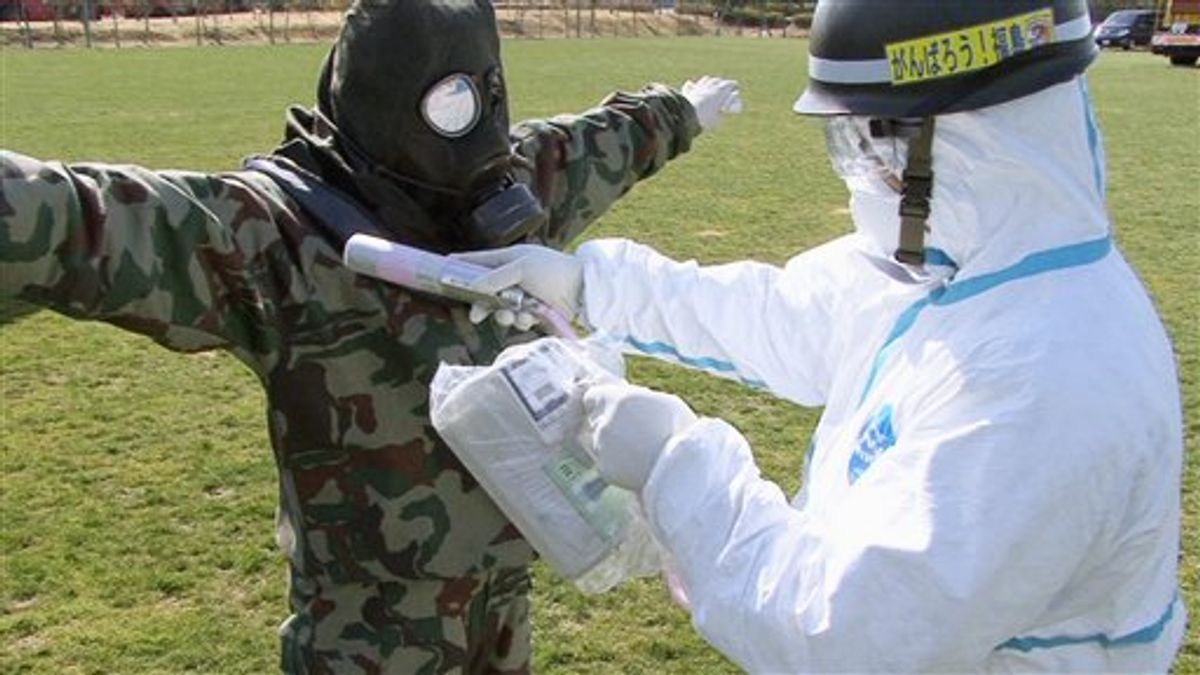Japanese authorities may for the first time strictly enforce their evacuation zone around a crippled nuclear plant, citing concerns Wednesday over radiation risks for residents returning to check on their homes.
About 70,000-80,000 people were living in the 10 towns and villages within 12 miles (20 kilometers) of the Fukushima Dai-ichi plant before the March 11 earthquake and tsunami wrecked its power and cooling systems, setting off the worst nuclear power crisis since the 1986 catastrophe at Chernobyl.
Virtually all of the residents left when the government ordered the area evacuated on March 12, but some occasionally have returned and police cannot legally block them. There currently is no penalty for violating the zone.
"We are considering setting up 'caution areas' as an option for effectively limiting entry" to the zone, Chief Cabinet Secretary Yukio Edano said.
Prime Minister Naoto Kan will meet with local officials and evacuees to discuss the plans during a visit to the affected region Thursday, Edano said.
Now that the situation at the plant appears to have stabilized somewhat, both residents and authorities are considering how to best weather a protracted evacuation. Residents have been demanding they be allowed to check their homes and collect belongings, while government officials are worried about radiation exposure.
Police have set up a few roadblocks on main roads into the area but merely note down license plate numbers of cars going in.
"There is a realization of a need to have a stronger enforcement of the area," said Noriyuki Shikata, one of Edano's deputies. "Both the issue of ... strong enforcement of the area and a realization of temporarily going back home is something we have to closely coordinate with local municipalities."
Shikata did not provide details of how the government might restrict entry to the area or when the restrictions would be put in place.
"There are also issues surrounding non-residents who are entering the area. There are people who may steal things," he said.
Kan, who will also visit a nuclear crisis management center during his Thursday trip, has been under fire from the opposition for the government's response to the nuclear crisis. Edano suggested that plant operator Tokyo Electric Power Co. should have been better prepared.
"Aside from the question of whether the accident could have been predicted, there was not sufficient preparation based on an anticipation, and there is no mistake about that," he said. "We urge all nuclear operators to immediately take any possible precaution based on the lesson from the Fukushima nuclear accident, and not wait until details of the accident are examined."
In a step toward restoring the crippled plant's cooling systems, TEPCO has been pumping highly radioactive water from the basement of one of its turbine buildings to a makeshift storage area. Ridding the plant of pools of contaminated water will free access for workers trying to restore the plant's cooling systems, but it may take months.
Still, a senior official at the U.N. nuclear agency suggested the worst of the radiation leaks may be over.
The total amount of radiation released is expected to be only a "small increase from what it is today" if "things go as foreseen," said Dennis Flory, a deputy director general at the International Atomic Energy Agency in Vienna.
IAEA experts are discussing ways to help Japan meet targets laid out in a blueprint for ending the crisis that TEPCO released over the weekend. Its plans call for achieving a cold shutdown of the plant within nine months. But government officials acknowledge that setbacks could slow the timeline.
In the meantime, TEPCO is continuing to spray water into the reactors and their spent fuel storage pools to help prevent them from overheating and releasing still more radiation.
TEPCO said Wednesday it has begun distributing applications for compensation to residents forced to evacuate from their homes around the plant. The company is offering about $12,000 per household as interim compensation.
People elsewhere in the disaster zone who lost homes and suffered from other damage say help has been slow to materialize.
Meanwhile, trade figures showed Japan's exports fell for the first time in 16 months in March, hit by the fallout from the disasters, which destroyed factories and damaged ports.
Auto exports especially took a beating, falling by 28 percent, as Toyota Motor Corp., Honda Motor Co. and Nissan Motor Co. were forced to suspend Japanese production due to shortages of components.
Associated Press writers Eric Talmadge in Fukushima and Malcolm Foster, Shino Yuasa and Yuri Kageyama in Tokyo contributed to this report.



Shares